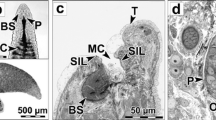Abstract
Structure and ultrastructure of the digestive tract of the ectoparasitic stages of the Antarctic isopod Gnathia calva, collected in the Weddell Sea and around the Antarctic Peninsula in the 1984–1985 season, are briefly described. There are only two digestive glands, with an ultrastructure similar to that of other isopods. The gut is divided into six regions: oesophagus, stomach, dilatable reservior for sucked-in blood, sphincter, rectal vesicle with symbiontic bacteria, and rectum. The highly dilatable anterior hindgut (reservoir) takes part in the resorption of nutrients and stores lipids and glycogen. The rectal vesicle has an epithelium with all the features of an organ with high metabolism and the capacity for the transportation of small molecules. The surface is increased by irregular microvilli. A very thin intima and a basal labyrinth are present. The presence of symbiontic bacteria is discussed in correlation with the haematophagous nutrition of G. calva.
Similar content being viewed by others
Literature cited
Becker, G. and W. D. Kampf: Die Holzbohrassel der Gattung Limnoria (Isopoda) und ihre Lebensweise, Entwicklung und Umweltabhängigkeit. Z. angew. Zool. 42, 477–517 (1955)
Boyle, P. J. and R. Mitchell: Absence of microorganisms in crustacean digestive tracts. Science, Wash. D.C. 200, 1157–1159 (1978)
Buchholz, R.: Über Hemioniscus, eine neue Gattung parasitischer Isopoden. Z. wiss. Zool. 16, 303–327 (1866)
Buchner, P.: Endosymbiose der Tiere mit pflanzlichen Mikroorganismen, 771 pp. Basel, Stuttgart: Verlag Birkhäuser 1953
Dall, W. and D. J. W. Moriarty: Functional aspects of nutrition and digestion. In: The biology of Crustacea, Vol. 5, pp 215–261. New York: Academic Press 1983
Hassal, M. and J. B. Jennings: Gut structure and function, and their adaptive significance in the terrestrial isopod Philoscia muscorum (Scopoli, 1763). Biol. Bull. mar. biol. Lab., Woods Hole 149, 346–364 (1975)
Holdich, D. M. and K. R. Mayes: A fine-structural re-examination of the so-called ‘midgut’ of the isopod Porcellio. Crustaceana 29, 186–192 (1975)
Holdich, D. M. and N. A. Ratcliffe: A light and electron microscope study of the hindgut of the herbivorous isopod, Dynamene bidentata. Z. Zellforsch, 111, 209–227 (1970)
Hryniewiecka-Szyfter, Z. and J. Tyczewska: The fine structure of the hepatopancreas of Mesidotea entomon L. (Crustacea, Isopoda). Bull. Soc. Amis Sci. Lett. Poznan Ser. D. Sci. Biol. 0 (18), 73–80 (1978)
Hryniewiecka-Szyfter, Z. and J. Tyczewska: Fine structure and localization of alcaline phosphatase in the hindgut of Mesidotea entomon (Isopoda, Crustacea). Bull. Soc. Amis Sci. Lett. Poznan Ser. D. Sci. Biol. 0 (19), 57–64 (1979)
Hryniewiecka-Szyfter, Z. and J. Tyczewska: Morphological and enzymatic evidence for ion transport in the hindgut of Asellus aquaticus (Crustacea, Isopoda). Bull. Soc. Amis Sci. Lett. Poznan Ser. D. Sci. Biol. 0 (20), 95–100 (1980)
Jeuniaux, C.: Chitinase et bactéries chitinolytiques dans le tube digestive d'un cloporte (Porcellio scaber Latr.) (Isopode Oniscoide). Arch. Int. Physiol. Biol. 64, 583–586 (1956)
Jones, D. A.: The functional morphology of the alimentary tract in Eurydice pulchra. J. Zool., Lond. 156, 363–376 (1968)
Monod, T.: Les Gnathiidae, essai monographique (morphologie, biologie, systématique). Mém. Soc. Sci. Nat. Maroc 13, 1–667 (1926)
Mouchet, S.: Contribution à l'étude de la digestion chez les Gnathiidae. Bull. Soc. Zool. France 536, 442–452 (1928)
Palackal, T., L. Faso, J. L. Zung, G. Vernon and R. Witkus: The ultrastructure of the hindgut epithelium of terrestrial isopods and its role in osmoregulation. In: The biology of terrestrial isopods, pp 185–198. Ed. by S. L. Sutton and D. M. Holdich. Oxford: Clarendon Press 1984
Ray, D. L.: Nutritional physiology of Limnoria. In: Marine boring and fouling organisms, pp 46–61. Ed. by D. L. Ray. Washington: University of Washington Press 1959
Ray, D. L. and F. R. Julian: Occurrence of cellulase in Limnoria. Nature, Lond. 169, 32–33 (1952)
Romestand, B. and J. B. Trilles: Au sujet d'une substance à activité antithrombinique mise en évidence dans les glandes latéro-oesophagiennes de Meinertia oestroides (Cymothoidae). Z. Parasitenkunde 50, 87–92 (1976a)
Romestand, B. and J. B. Trilles: Production d'une substance anticoagulante par les glandes exocrines céphalothoraciques des isopodes Cymothoidae Meinertia oestroides (Risso, 1826) et Anilocra physodes (L., 1758) (Isopoda, Flabellifera, Cymothoidae). C.R. Acad. Sci. Paris 282D, 663–665 (1976b)
Scheloske, H. W.: Vergleichend-morphologische und funktionelle Untersuchungen am Magen von Asellus aquaticus. Zool. Jb. Anat. 95, 519–573 (1976)
Seltmann, G.: Die bakterielle Zellwand, 207 pp. Stuttgart: G. Fischer Verlag 1982
Shrewsbury, J. F. D. and G. J. Barson: The flora of the intestinal tract of the terrestrial isopod commonly known as the wood-louse. J. Path. Bact. 64, 619–625 (1952)
Smith, J. U., M. J. Nadakavukaren and H. R. Hetzel: Light and electron microscopy of the hepatopancreas of the isopod Asellus intermedius. Cell Tissue Res. 163, 403–410 (1975)
Vernon, G. M., L. Herold and E. R. Witkus: Fine structure of the digestive tract epithelium in the terrestrial isopod, Armadillidium vulgare. J. Morphol. 144, 337–360 (1974)
Wägele, J. W.: Zur Phylogenie der Anthuridea (Crustacea, Isopoda). Mit Beiträgen zur Lebensweise, Morphologie, Anatomie und Taxonomie. Zoologica, Stuttgart 132, 1–127 (1981)
Wägele, J. W.: Observations on nutrition and ultrastructure of digestive tract and fat body of the giant paranthurid Accalathura gigantissima Kussakin. Polar Biol. 4, 33–43 (1985)
Wägele, J. W.: Description of the postembryonal stages of the Antarctic fish parasite Gnathia calve Vanhöffen (Crustacea: Isopoda) and synonymy with Heterognathia Amar & Roman. Polar Biol. 7, 77–92 (1987)
Wägele, J. W., U. Welsch and W. Müller: Fine structure and function of the digestive tract of Cyathura carinata (Krøyer) (Crustacea, Isopoda). Zoomorphology 98, 69–88 (1981)
Wagner, N.: Observations sur l'organisation et le développement des Ancées. Bull. Acad. Imp. Sci. Saint-Pétersbourg 10, 497–502 (1866)
Author information
Authors and Affiliations
Additional information
Communicated by O. Kinne, Oldendorf/Luhe
Rights and permissions
About this article
Cite this article
Juilfs, H.B., Wägele, J.W. Symbiontic bacteria in the gut of the blood-sucking Antarctic fish parasite Gnathia calva (Crustacea: Isopoda). Mar. Biol. 95, 493–499 (1987). https://doi.org/10.1007/BF00393092
Accepted:
Issue Date:
DOI: https://doi.org/10.1007/BF00393092



